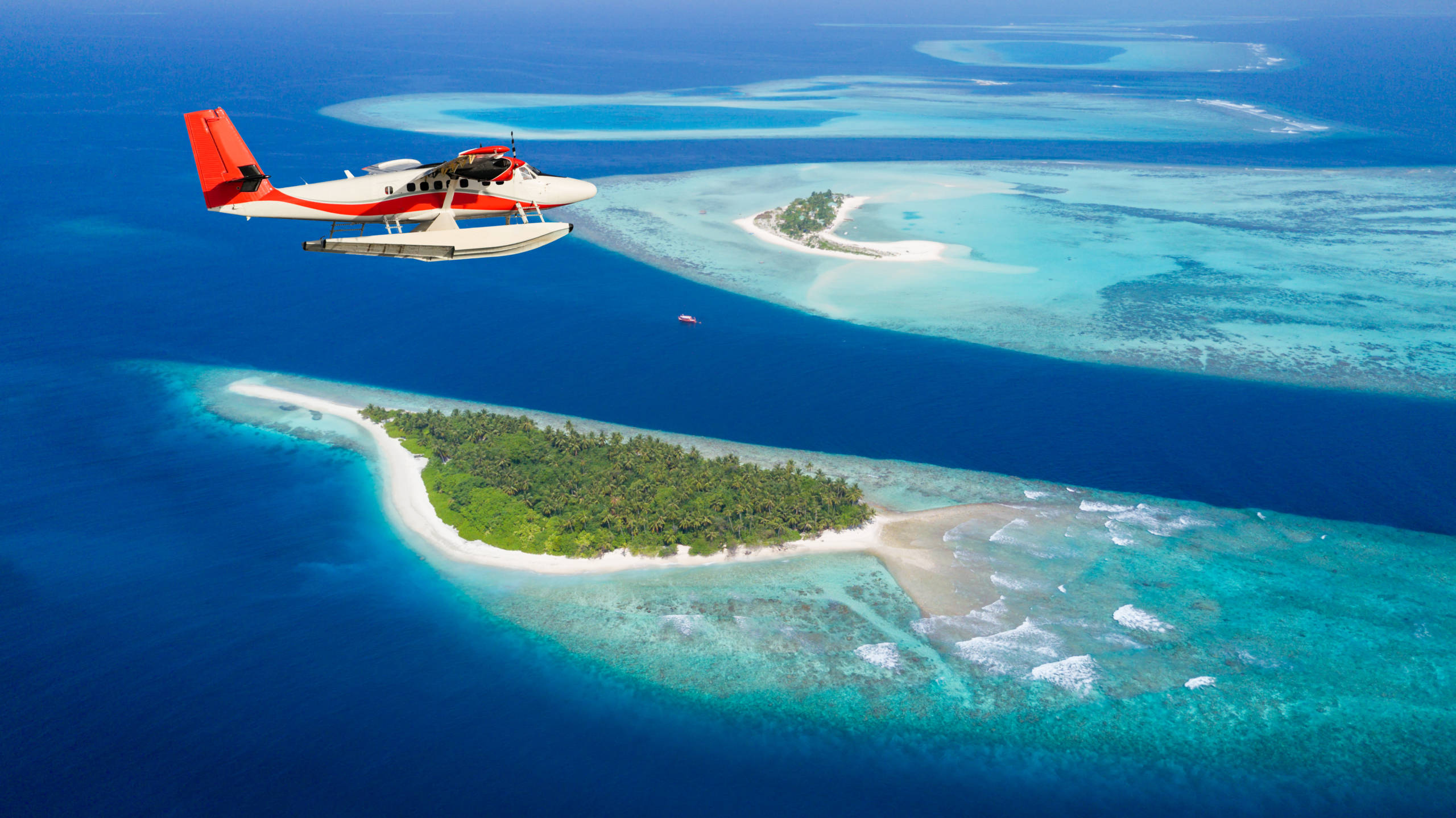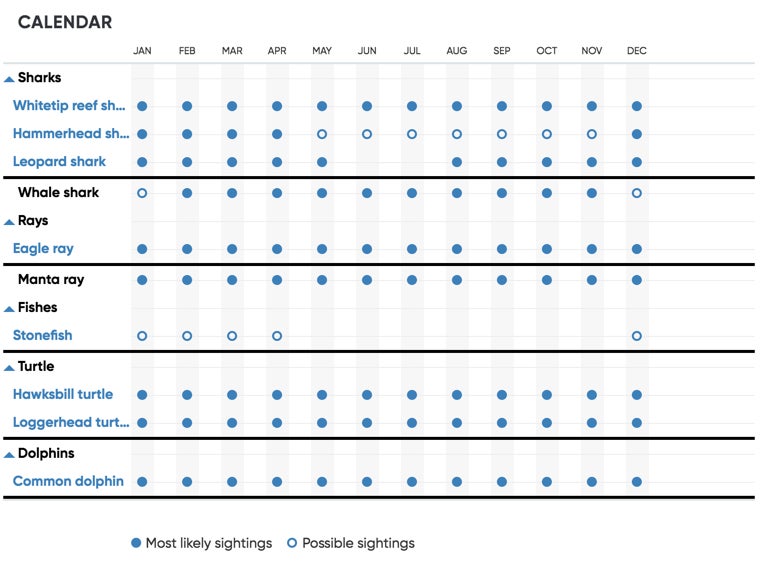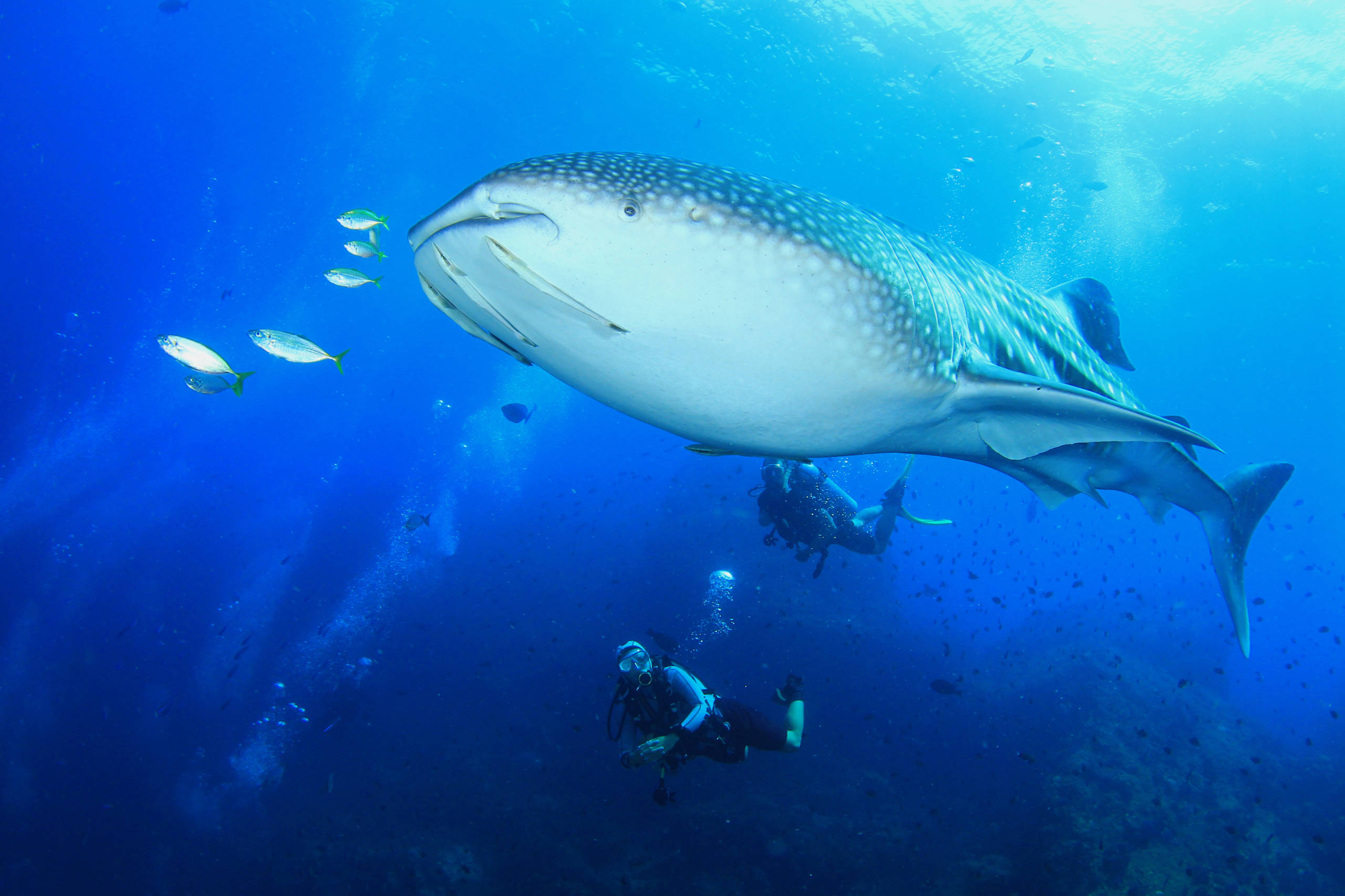The Maldives is an archipelago comprising some 1,200 islands, only about 200 of which are inhabited. With 26 atolls, coral reefs and coral islands in the archipelago, it’s no wonder this remote destination in the Arabian Sea is famous for its world-class scuba diving.

When to dive in the Maldives
The Maldives have a tropical climate, and water temperatures range from 80 to 86 degrees year-round, making the diving good nearly any time of year. That said, the absolute best time to visit the Maldivesfor a scuba trip are between the months of January and April, when the weather is dry and warm and visibility is best.
May through July are often considered the months when the weather is most unsettled and divers could encounter reduced visibility. The period between August and November is the best time of year to see “big” sea creatures such as manta rays and whale sharks, because of an increase in plankton in the water due to currents caused by the southwest monsoon.
In December, divers can expect a fair amount of wind and rain, possibly affecting visibility.
Here’s a calendar from PADI that indicates the best viewing times for many of the popular marine life:

What you’ll see
Due to the consistent water temperatures, larger marine animals such as turtles, reef sharks, mantas and whale sharks can be found throughout the year. In fact, spotting many of these (somewhat) elusive creatures is usually more dependent on factors like the tide, sunrise and sunset.
Basically, you’re likely to see common dolphins; turtles (hawksbill and loggerheads); manta and eagle rays; and whitetip reef sharks every month of the year.
Hammerhead sharks are most likely to be seen between December and April, with some sightings possible between May and November. Leopard sharks can be seen every month except June and July.
Your best chance of seeing whale sharks is between February and November, and stonefish sightings are possible between December and April.
Dive environments
The Maldives is host to a variety of diverse dive environments, including reef dives, drift dives and wrecks that provide opportunities for divers at any skill level.
Diving in and around the atolls, you’ll find rock pinnacles, called thila, as well as underwater structures such as caverns, overhangs and swim-throughs. Wreck diving in the Maldives is usually less about the wreck itself and more about the artificial reefs that have formed around the sunken structures.
There are a number of channels in the Maldives, too, where the atolls meet the ocean. Because of the currents that run through these areas, they are the perfect spot for drift dives where the strong currents bring in larger marine life like sharks, tuna and mantas.
Lastly, you’ll find lagoon environments on the interior of the atolls. They’re mostly protected from the current and are usually fairly shallow, making them good locations for practice dives and diving classes.
Thila, Giri and Faru etc
There are many different names for the types of dives you find in The Maldives and Thila, Giri and Faru are three different examples of reef structures, divers can usually find sites that offer gentle, calm conditions suitable for beginners, as well as more advanced areas which are more exposed to currents. Below is a list of the different names and their meanings.
- Thila is a pinnacle that is completely submerged in water and can often be large enough to explore the entire area in one dive. Typically, the top of Thila lies at a depth of eight meters and deeper. The coral formation, mostly in a circle shape different diameter, the top of the reef can be crossed by each tide and all weather conditions. Thila can be located inside the atoll or in the channel (kandu). The pinnacle is often exposed to strong currents and is usually covered with amazing soft corals and sea fans; As a rule, most fish can be found at the point where the current runs across a reef. The most important rule on diving in Thila is to dive quickly until the current takes you past the most interesting. Next – just take the side where Thila is washed by the current, and just have time to watch!
- Giri is a separate reef not connected to the island. They are similar to Thila, but the main difference is that the tops of these coral spots often reach the ocean surface or may even be exposed during low tides. Most of the time around “Giri” there are very few currents, which makes them great sites for novice divers and night dives.
- Faru is a small fringing reef, often in the shape of a horseshoe, the top of which extends and is visible from the ocean’s surface. Sometimes it breakes the surface and goes outside to deeeps more than 300 meters. Although they are usually of interest only to divers in areas where the current is stronger, the shallow depths around Faru make them popular for snorkeling. Usually Faru roof (the top point of the reef) – depth from half a meter to three.
- Kandu is a channel that’s connect the inside and outside of the atoll.
- Haa is it the same like a thila without any coral covered top reef.
- Fushi is the name for a little island on top of a faru.
- Finolhu is the name for a small island with limited vegetation.
- Rha is the meaning of normal sized islands.
- Atoll, means, a big coral boundery with a huge amount of islands inside, the max depth is around 70m
Where to dive in the Maldives
There are dozens and dozens of dive sites in the Maldives, these are a few of our favorites:
Ari Atoll
Known for its clear blue waters and accessibility, the Ari Atoll is home to many of the best dive sites in the Maldives. Maaya Thila, for example, located on the southern end of the atoll, consistently ranks as one of the best sites in the area. The pinnacle starts about 20 feet deep and stretches down to 100 feet, and the area is home to marine life such as barracuda, stingrays and more. Those diving after sundown will likely get to experience a reef shark feeding frenzy.
Baa Atoll
The Baa Atoll is a UNESCO Biosphere Reserve with dive sites for both beginners and advanced divers. Divers should have the opportunity to see the ever-popular manta rays and whale sharks, as well as marvel in the atoll’s overhangs and swim-throughs.
The Dhonfanu Thila site is one popular swim-through. Around 82 feet deep, divers can enter the narrow swim-through and ascend to its exit just under 60 feet below the ocean’s surface. Hanifaru Bay is one of the few places in the world where whale sharks congregate to mate and where divers can dive with masses of manta rays.
Fuvahmulah Atoll
This particular atoll is known for the rare shark species that frequent the area. Lucky divers may have a chance to encounter tiger sharks, thresher sharks, whale sharks and even hammerheads.
Being one of the Maldives’ most southerly atolls, many of the dive sites here are still being explored and are better suited for more advanced divers.

Male Atoll
The Male Atoll is divided into two sections: the North Male Atoll and the South Male Atoll. The North Male Atoll is one of the most visited dive areas in the country, while the South Male Atoll tends to be slightly less trafficked.
On the South Male Atoll you’ll find Cocoa Thila, a pinnacle that stretches over 1,000 feet long and nearly 100 feet deep. Due to the area’s strong currents, this site is better suited for experienced divers but offers a wide variety of marine life.
Vaavu Atoll
The Vaavu Atoll offers excellent channel diving for divers of all levels. One of the most notable sites in the atoll is Fotteyo Kandu, a channel with a number of large overhangs and caves (often referred to as one of the best dive sites in the world).
